|
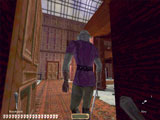 The many
excellences of “Thief: The Dark Project” have been well documented
since its release during the fall of 1998. With a premise that radically
reconsidered what a FPS could be and do—here, the “s” stands for
“sneaker” instead of “shooter”—along with one of the best
stories and one of the most engaging protagonists (the caustic cutpurse
Garrett) ever scripted for a pc game, “Thief” swiftly emerged as a
title that signaled a new epoch of game design. “Thief’s” emphasis
on stealth, patience, and problem solving seems to have had a profound
effect on the design of some of the most significant titles to hit the
shelves after its release, namely “Half-Life.” Indeed,
“Half-Life’s” reluctant hero, Gordon Freeman, possesses a
disillusioned sensibility very similar to Garrett’s searing skepticism,
and both games are set in disturbing hybrid environments where the
opposing impulses of technology and the supernatural threaten the very
foundations of human existence. Such complex characters and atmospheric
environments make for great storytelling, and when brought together with
superior game design and playability, then the industry clearly gives the
people what they want—strategy, suspense and
story. Eidos once again fulfills all three of these gaming desires with
the release of the much-anticipated second chapter of the “Thief”
saga: “Thief II: The Metal Age.” The many
excellences of “Thief: The Dark Project” have been well documented
since its release during the fall of 1998. With a premise that radically
reconsidered what a FPS could be and do—here, the “s” stands for
“sneaker” instead of “shooter”—along with one of the best
stories and one of the most engaging protagonists (the caustic cutpurse
Garrett) ever scripted for a pc game, “Thief” swiftly emerged as a
title that signaled a new epoch of game design. “Thief’s” emphasis
on stealth, patience, and problem solving seems to have had a profound
effect on the design of some of the most significant titles to hit the
shelves after its release, namely “Half-Life.” Indeed,
“Half-Life’s” reluctant hero, Gordon Freeman, possesses a
disillusioned sensibility very similar to Garrett’s searing skepticism,
and both games are set in disturbing hybrid environments where the
opposing impulses of technology and the supernatural threaten the very
foundations of human existence. Such complex characters and atmospheric
environments make for great storytelling, and when brought together with
superior game design and playability, then the industry clearly gives the
people what they want—strategy, suspense and
story. Eidos once again fulfills all three of these gaming desires with
the release of the much-anticipated second chapter of the “Thief”
saga: “Thief II: The Metal Age.”
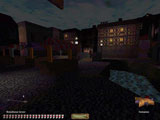 Readers
familiar with other reviews of “Thief II” have probably noted that the
earlier reviewers claim, with affection, that this sequel offers more of
the same excellent narrative and gameplay that characterized “The Dark
Project,” along with a few new goodies thrown into the mix just for the
purpose of making “The Metal Age” the “same, but different.”
Otherwise, suggest the commentators, “Thief II” does not really offer
much more in the way of play, look and narrative than its predecessor.
Now, this reviewer began playing “The Metal Age” around the time the
earliest reviews were hitting the newsstands and browsers, and so was
mindful of these criticisms. After spending about a month with the game,
though, I’ve concluded that the other critics have not really played
“Thief II,” at least not played it to any extent that would allow them
to explore its depth and breadth. For, in the end, what distinguishes
“The Metal Age” from “The Dark Project” is a subtle variation of
theme and engine design that actually allows players to choose how they
will play this game by asking them to look at the game in different ways,
from angles different from those framed in “Thief.” In other words,
players can passively engage “Thief II” as a familiar and logical
sequel to “The Dark Project,” or they can, like Garrett, risk
foregoing the cozy limitations of the first game for the more challenging
and dynamic possibilities present—and perhaps necessary—in “The
Metal Age.” Readers
familiar with other reviews of “Thief II” have probably noted that the
earlier reviewers claim, with affection, that this sequel offers more of
the same excellent narrative and gameplay that characterized “The Dark
Project,” along with a few new goodies thrown into the mix just for the
purpose of making “The Metal Age” the “same, but different.”
Otherwise, suggest the commentators, “Thief II” does not really offer
much more in the way of play, look and narrative than its predecessor.
Now, this reviewer began playing “The Metal Age” around the time the
earliest reviews were hitting the newsstands and browsers, and so was
mindful of these criticisms. After spending about a month with the game,
though, I’ve concluded that the other critics have not really played
“Thief II,” at least not played it to any extent that would allow them
to explore its depth and breadth. For, in the end, what distinguishes
“The Metal Age” from “The Dark Project” is a subtle variation of
theme and engine design that actually allows players to choose how they
will play this game by asking them to look at the game in different ways,
from angles different from those framed in “Thief.” In other words,
players can passively engage “Thief II” as a familiar and logical
sequel to “The Dark Project,” or they can, like Garrett, risk
foregoing the cozy limitations of the first game for the more challenging
and dynamic possibilities present—and perhaps necessary—in “The
Metal Age.”
 The other
reviewers are accurate insofar as they assert that this game really does
offer more of the same: stealth, patience and strategy always preserve
more health points in “The Metal Age” and get the player farther in
the game than aggressive combat-oriented play. Admittedly, one of the
often-repeated critiques of “Thief” was that despite the promotion of
these furtive tactics, both in the game literature and design, “The Dark
Project” really didn’t provide many opportunities to emphasize secrecy
and cunning. Instead, players and reviewers complained that Garrett had to
deal with too many monsters—notably burricks (big lizards), mantis men,
monkey boys, and those damned zombies—and pick his way through too many
haunted landscapes and cathedrals lousy with ghosts to sneak around and
exercise thief-craft in any sort of convincing way. The other
reviewers are accurate insofar as they assert that this game really does
offer more of the same: stealth, patience and strategy always preserve
more health points in “The Metal Age” and get the player farther in
the game than aggressive combat-oriented play. Admittedly, one of the
often-repeated critiques of “Thief” was that despite the promotion of
these furtive tactics, both in the game literature and design, “The Dark
Project” really didn’t provide many opportunities to emphasize secrecy
and cunning. Instead, players and reviewers complained that Garrett had to
deal with too many monsters—notably burricks (big lizards), mantis men,
monkey boys, and those damned zombies—and pick his way through too many
haunted landscapes and cathedrals lousy with ghosts to sneak around and
exercise thief-craft in any sort of convincing way.
Well,
Looking Glass Studios, the house that introduced and continues to develop
“Thief,” should be commended for taking these criticisms to heart;
“Thief II” is a radical departure from “The Dark Project.” In
“The Metal Age,” for example, Garrett spends almost all of his time
above, about, and beneath the streets of his insidious City. While there
are a couple of surprising exceptions to this assertion (play the
“Pursuit” mission and freak out in the pagan village), the action and
plot in this game are so tightly constructed that Aristotle himself would
have been pleased to observe that the unities of place and action have
been so well preserved. In addition, Garrett’s directives in each
mission are decidedly thievish, and the most challenging levels require
Garrett to elude an ambush, trail a courier, and case a suspicious
nobleman’s mansion, all the while remaining undetected, pocketing a
substantial stash of loot in the process, and finally retracing his steps.
To successfully fulfill most of the scenarios in “Thief II,” Garrett
must keep the bloodshed to a minimum, and even blackjacking is
limited—or forbidden—in a couple of missions. Veteran “Thief”
players might remark that the first chapter included similar restrictions
for some of the missions. But such limitations only applied in the
“Hard” or “Expert” modes of play. The restrictions outlined above
characterize the “Normal” level of play in “Thief II”! From the
outset, then, “The Metal Age” demands a more rigorously stealthy
sensibility than its precursor. Players who take on the challenge will be
rewarded with more opportunities to pick pockets and locks, discover the
several secrets that are scattered throughout each level, and undertake
new objectives that arise in the course of any given mission. Often, the
discovery of secrets during the fulfillment of a mission allows gamers to
play “Thief II” almost like a “choose your own adventure” story,
where new possibilities result from choices made early on in level.
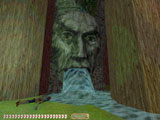 Complimenting
(or complicating) these new narrative features is an improved AI that
enhances Garrett’s interaction with his environments and NPCs. In
respect to this latter point in particular, this reviewer continues to
marvel at how much quicker—of wit
as well as reflex—the NPCs are. In “The Metal Age,” Garrett’s
human adversaries (the City watch, hired arms and the cripplingly
dexterous and brutal Mechanists, of which more will be said later) are not
only better-armed and more adept at hand-to-hand combat—players actually
engage in protracted sword duels in “Thief II”—but they also have
more sensitive ears and eyes. To illustrate, if a Hammerite “heard”
Garrett in “The Dark Project,” players could usually wait out the
NPC’s suspicions and then proceed to sneak around. In “The Metal
Age,” though, once an NPC hears (or sees) Garrett, players have only a
few seconds to ditch Garrett’s snitch and whatever backup is surely on
its way. Garrett, on the other hand, seems all too human at times in
respect to his abilities and reflexes. Also, the NPCs in “Thief II”
have been more extensively scripted, and so say much more—to Garrett and
each other—than they ever did in the first game. Sometimes, as other
reviewers have pointed out, the results are outright hilarious. A flaming
logomachy waged between rival pairs of manor guards in the “Rooftops”
mission, for example, becomes a ridiculous, knee-slapping send-up of
corrupt Shakespeareanisms. Complimenting
(or complicating) these new narrative features is an improved AI that
enhances Garrett’s interaction with his environments and NPCs. In
respect to this latter point in particular, this reviewer continues to
marvel at how much quicker—of wit
as well as reflex—the NPCs are. In “The Metal Age,” Garrett’s
human adversaries (the City watch, hired arms and the cripplingly
dexterous and brutal Mechanists, of which more will be said later) are not
only better-armed and more adept at hand-to-hand combat—players actually
engage in protracted sword duels in “Thief II”—but they also have
more sensitive ears and eyes. To illustrate, if a Hammerite “heard”
Garrett in “The Dark Project,” players could usually wait out the
NPC’s suspicions and then proceed to sneak around. In “The Metal
Age,” though, once an NPC hears (or sees) Garrett, players have only a
few seconds to ditch Garrett’s snitch and whatever backup is surely on
its way. Garrett, on the other hand, seems all too human at times in
respect to his abilities and reflexes. Also, the NPCs in “Thief II”
have been more extensively scripted, and so say much more—to Garrett and
each other—than they ever did in the first game. Sometimes, as other
reviewers have pointed out, the results are outright hilarious. A flaming
logomachy waged between rival pairs of manor guards in the “Rooftops”
mission, for example, becomes a ridiculous, knee-slapping send-up of
corrupt Shakespeareanisms.
Heightened
vigilance is not merely an improvement for the NPCs, though. It is an
integral theme throughout “Thief II,” and will probably continue to be
developed throughout the life of any “Thief” series. Players who
finished “The Dark Project” surely recall Garrett’s unforgettable
ocular mutilation at the hands of the Trickster and the mysterious
mechanical eye subsequently implanted in Garrett’s head by the Keepers.
In “The Metal Age,” Garrett’s mechanized orb, quite literally,
provides a sardonic witness to the manic mechanization that has
transformed the City from a once bustling and colorful port town into a
drab commercial outpost under constant surveillance by merciless and
mysterious power brokers, especially Sheriff Truart and his sponsor Karras,
the Mechanist High Priest and Prophet. The most palpable and disturbing
signs of this civic metamorphosis are the austere and ornate security
probes, the “Children of Karras,” that keep watch throughout the City:
the Children preserve their vigil everywhere, within the walls of private
homes as well as in the streets of the City.
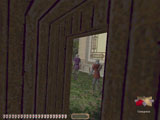 Essentially,
the Children of Karras are several species of robots, all of which wreak
havoc in their own unique ways. The mobile Children are R2-D2-like
contraptions that patrol any locale used as a HQ by the Mechanists, and
which either possess an annoying tattletale technology or devastating
firepower. Either way, it behooves Garrett to take out these kids any way
he can. Players will discover that water and fire arrows, as well as
landmines—holdover weaponry from “The Dark Project”—will have new
applications in “Thief II.” Karras’ other Children are not nearly as
sophisticated, but they are potentially more troublesome for Garrett.
Either mounted in walls or ceilings, these Children are really a pair of
devices consisting of a rotating motion-sensitive alarm coupled with a
bomb-lobber or bolt-thrower that hurls hell at whatever the alarm detects.
What’s really eerie about all of these Children of Karras, though, is
their common feature—a humanoid metal mask or face equipped with a
mechanical eye. Either way, it’s sort of ingenious how Looking Glass has
preserved this motif of the watching dead in these games: zombies in
“The Dark Project,” Children of Karras in “The Metal Age.” Essentially,
the Children of Karras are several species of robots, all of which wreak
havoc in their own unique ways. The mobile Children are R2-D2-like
contraptions that patrol any locale used as a HQ by the Mechanists, and
which either possess an annoying tattletale technology or devastating
firepower. Either way, it behooves Garrett to take out these kids any way
he can. Players will discover that water and fire arrows, as well as
landmines—holdover weaponry from “The Dark Project”—will have new
applications in “Thief II.” Karras’ other Children are not nearly as
sophisticated, but they are potentially more troublesome for Garrett.
Either mounted in walls or ceilings, these Children are really a pair of
devices consisting of a rotating motion-sensitive alarm coupled with a
bomb-lobber or bolt-thrower that hurls hell at whatever the alarm detects.
What’s really eerie about all of these Children of Karras, though, is
their common feature—a humanoid metal mask or face equipped with a
mechanical eye. Either way, it’s sort of ingenious how Looking Glass has
preserved this motif of the watching dead in these games: zombies in
“The Dark Project,” Children of Karras in “The Metal Age.”
 Now,
PC game players (and popular culture critics of other stripes out there)
could probably go into the possibilities of this eye motif in “Thief”
for, well, at least longer than it takes to play the game. Add to these
creepy connections between Garrett and the Children the observation that
Looking Glass Studio’s logo graphic depicts an impressionistic line
rendering of a human face distinguished by a telescoping eye, as well as
the idea that “eidos,” at least in Ancient Greek, signifies
“something seen; a shape, a form,” and anyone ambitious enough to
undertake the project might have quite a thesis to pursue. Now,
PC game players (and popular culture critics of other stripes out there)
could probably go into the possibilities of this eye motif in “Thief”
for, well, at least longer than it takes to play the game. Add to these
creepy connections between Garrett and the Children the observation that
Looking Glass Studio’s logo graphic depicts an impressionistic line
rendering of a human face distinguished by a telescoping eye, as well as
the idea that “eidos,” at least in Ancient Greek, signifies
“something seen; a shape, a form,” and anyone ambitious enough to
undertake the project might have quite a thesis to pursue.
For this
reviewer, the connections are not arbitrary and point up compelling
arguments for the idea that when we insist upon rigorous distinctions
between the graphics of a game and its story, then we overlook the very
powerful notion that game graphics, how a game looks, are
story. While other reviewers have complained of how “Thief II” looks
too much like “Thief,” this reviewer contends that Looking Glass and
Eidos are up to something more interesting. Namely, they are sticking to
the assertion, shared by so many of “The Dark Project’s” critics,
that from the beginning, “Thief” offered players a different, visually
articulated gaming language, and “Thief II” further parses and
enriches this language. Indeed, “The Metal Age” introduces new
vocabulary into the “Thief” phenomenon, and in so doing, potentially
changes, in profound ways, how the game can be played.
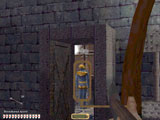 Some of
these new elements (improved AI and tougher heists) have been discussed
above. Other commentators have mentioned others, such as new weapons and
tools (vine arrows, invisibility potions, slowfall potions, flares and
scouting orbs, which are yet another type of mechanical eye) and new
characters (most notably, the Mechanists). The most significant addition
to “Thief II,” however, at least to this reviewer, is the spectrum of
points of view players are allowed. As suggested earlier, Garrett spends
at least one mission on the rooftops above the City. But Garrett also has
the opportunity to assume this bird’s eye view in other missions.
Players can maneuver the thief above his adversaries’ heads in almost
any environment in “Thief II.” Vine arrows, after all, will cling to
metal work, grates and rocky outcrops as well as penetrate wooden beams
and surfaces. And when played from the heights, Garrett’s game really
changes. Some of
these new elements (improved AI and tougher heists) have been discussed
above. Other commentators have mentioned others, such as new weapons and
tools (vine arrows, invisibility potions, slowfall potions, flares and
scouting orbs, which are yet another type of mechanical eye) and new
characters (most notably, the Mechanists). The most significant addition
to “Thief II,” however, at least to this reviewer, is the spectrum of
points of view players are allowed. As suggested earlier, Garrett spends
at least one mission on the rooftops above the City. But Garrett also has
the opportunity to assume this bird’s eye view in other missions.
Players can maneuver the thief above his adversaries’ heads in almost
any environment in “Thief II.” Vine arrows, after all, will cling to
metal work, grates and rocky outcrops as well as penetrate wooden beams
and surfaces. And when played from the heights, Garrett’s game really
changes.
While his
perspective is decidedly privileged from the rafters and rooftops,
Garrett’s effectiveness—as an assailant, a pickpocket, and lockpick—is
limited. However, some of these new tools allow players to maneuver
Garrett in an espionage-like mode. Upon learning the layout of a level on
foot, for example, this player would have Garrett strategically drop
scouting orbs in corners, hallways, rooms and paths, take to the rafters
or treetops, and then proceed to fire rope and vine arrows in high-traffic
areas where our protagonist clearly needed to spend some time (for
looting, disabling security, steady jacking or collecting evidence). Thus,
Garrett can drop into high-security sectors, fulfill his directives and
then return to the relative safety of the eaves and leaves. Of course,
players can’t always anticipate where Garrett’s goodies will be best
utilized. Also, at times players need to strike at the most advantageous
moments, most of which do not occur when Garrett is poised to act near a
vine or a rope. In these situations, the slowfall potion is essential;
Garrett can suck down a draught, jump to the ground unharmed, do what he
needs to do, and then race to the next rope or vine and shimmy back to the
upper shadows. These new capabilities allow players to think of the world
of “Thief II” in even more dynamic, multivalent ways then they could
conceive of Garrett’s potential activity in the more linear “Thief.”
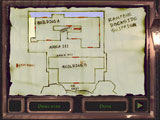 With the advent of the “The Metal Age,” then, it seems as
though Looking Glass
and Eidos have made a crucial assertion about continuity. Namely,
continuity
does not have to be linear. “Thief’s” designers elucidate this
notion by indicating
that “Thief II” necessarily proceeds from the story and design of
“Thief.” Indeed,
as players progress in the game, they will discover that Garrett comes
face to
face with his “past” when he meets up again with Viktoria, the
Trickster’s soul
sister, erstwhile squeeze, and the entity directly responsible for
Garrett’s
blindness. Players will also come to understand that the wars between the
Pagans and those who worship the Builder continue. In “Thief II,”
however,
players witness the results of a sort of reformation among the Builder’s With the advent of the “The Metal Age,” then, it seems as
though Looking Glass
and Eidos have made a crucial assertion about continuity. Namely,
continuity
does not have to be linear. “Thief’s” designers elucidate this
notion by indicating
that “Thief II” necessarily proceeds from the story and design of
“Thief.” Indeed,
as players progress in the game, they will discover that Garrett comes
face to
face with his “past” when he meets up again with Viktoria, the
Trickster’s soul
sister, erstwhile squeeze, and the entity directly responsible for
Garrett’s
blindness. Players will also come to understand that the wars between the
Pagans and those who worship the Builder continue. In “Thief II,”
however,
players witness the results of a sort of reformation among the Builder’s
adherents; the Hammerites slowly dwindle in number as their brothers
either
disappear or convert to Mechanists, who follow the new creeds of the
Builder as
set down by Karras. Besides being even more morally ruthless and
technologically advanced than their elder brethren, the Mechanists also
treat
women as equals. Indeed, women are more evident throughout “The Metal
Age,”
and their presence on all levels—from Viktoria (a naiad-goddess
composite) to
Lt. Mosley (Sherriff Truart’s right hand “man” and the captain of
the City patrol) to
the Mechanist nuns to the Pagan mothers—provides a potentially
terrifying
commentary on the larger implications of “Thief II’s” story. Namely,
we begin to
ask where women belong in a world threatened by the technologization of
human
life, and whether or not this very impulse to technologize, embodied by
Karras,
can be explained by reference to tidy gender dualities. We ask the same
questions in this biz, though, don’t we? Consider how many columns,
websites,
and now theses, dissertations and monographs are now devoted to the
relationships between women and technology, especially women and pc
gaming.
Maybe Looking Glass and Eidos begin to weigh in these larger discussions
by
simply including more women in “Thief II: The Metal Age.”
In the end,
then, I do concur with my game reviewing compadres. “Thief II” is the “same, but different.” But I consider this ambivalence a
compelling strength both in terms of narrative and design rather than a
weakness. The only substantive criticism that I have to offer is a
complaint about gamma in “The Metal Age.” Simply put, the game is too
dark. Raising the gamma doesn’t really help because it simply washes out
the screen and so destroys the atmosphere of the game. On the other hand,
maybe Looking Glass and Eidos are up to something even with this clinging,
impenetrable darkness. For when I wanted to play “Thief II” in the
middle of the day, I’d draw my curtains, slouch in front of my terminal,
and shroud my melon and monitor under an opaque blanket in order to
eliminate light so that I could see the screen well enough to play. In a
way, this game technologized this player to the extent that I had to
mediate my vision to accommodate the look of the game. A friend, walking
in on me in such a state, observed that I was, like one of the Children of
Karras—and like Garrett, too, maybe—a perversion of nature. She may be
right. Still, I am convinced that playing “Thief II: The Metal Age”
will prompt more than one gamer to ask “Who’s watching who?” Maybe
Looking Glass and Eidos will offer an insight into this matter with the
next chapter of “Thief” which, if Garrett gets his wish at the close
of this game, will require the Keepers to “tell more” about when all
the watching began … and why.
--Greg
Matthews |
